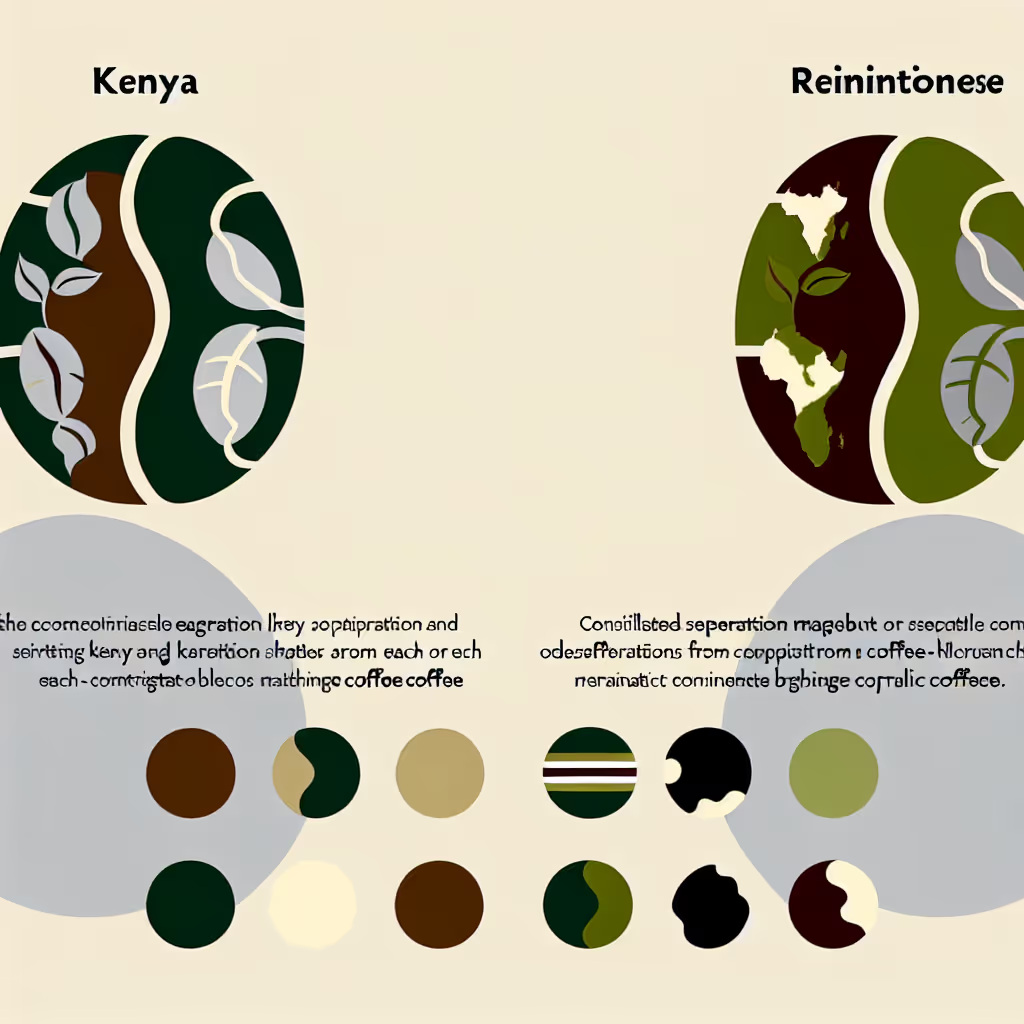Kenyan Vs. Dominican Coffee
This comparison explores the distinct qualities of Kenyan and Dominican coffees, examining their flavor profiles, growing conditions, and processing methods to help coffee enthusiasts make informed choices.

Brief Description
Kenyan coffee is renowned for its bright acidity, full body, and complex flavor profile. Grown in the rich volcanic soils of the Central Highlands, these beans benefit from ideal climate conditions and meticulous processing. The result is a cup that's bold, wine-like, and often described as the 'connoisseur's choice'. With notes ranging from blackcurrant to citrus, Kenyan coffee offers a truly unique and memorable tasting experience.
Dominican coffee is a hidden gem in the world of specialty coffee. Grown in the lush mountains of the Cibao Valley, these beans offer a unique flavor profile that reflects the island's rich terroir. With a perfect balance of sweetness and acidity, Dominican coffee is known for its smooth, medium body and delightful notes of chocolate and nuts. The country's ideal growing conditions and traditional farming methods contribute to producing a coffee that's both distinctive and delicious.
Importance of Comparison
Comparing Kenyan and Dominican coffee origins is crucial for coffee lovers seeking to expand their palate and understand the nuances of different coffee-producing regions. These two origins offer contrasting flavor profiles and represent unique terroirs, providing insight into how geography, climate, and processing methods influence coffee taste. By exploring these differences, consumers can make more informed purchasing decisions and develop a deeper appreciation for specialty coffee.
Key Attributes
Origin
Kenyan
Dominican


Consumer Guide
When choosing between Kenyan and Dominican coffee, consider your flavor preferences. If you enjoy bright, bold coffees with wine-like acidity and complex fruit notes, Kenyan coffee might be your ideal choice. Look for descriptors like 'blackcurrant' and 'citrus' on Kenyan coffee labels. For those who prefer a smoother, more balanced cup with chocolate and nutty undertones, Dominican coffee could be the perfect fit. Pay attention to the brewing method recommendations: both origins excel in pour-over and French press, but Kenyan coffee shines in cold brew, while Dominican coffee is great for espresso. Consider the altitude and processing methods as well; Kenyan coffee's higher altitude growth (1400-2100m) contributes to its complexity, while Dominican coffee's range (900-1700m) results in a more approachable flavor profile.
Expert Opinions
Coffee expert Maria Rodriguez notes, 'Kenyan coffee is often considered the pinnacle of brightness and complexity in the coffee world. Its unique double fermentation process contributes to its distinctive flavor.' On Dominican coffee, master roaster John Smith comments, 'The balanced profile of Dominican coffee makes it incredibly versatile. Its chocolate notes and smooth body create an approachable yet interesting cup that appeals to a wide range of coffee drinkers.' Both experts agree that these origins represent excellent examples of their respective regions' coffee production capabilities.
FAQs
Kenyan coffee is known for its bright acidity, full body, and complex flavors including blackcurrant, citrus, and floral notes. Dominican coffee, on the other hand, offers a smoother profile with prominent chocolate and nutty flavors, balanced acidity, and a medium body. While both may have citrus notes, they manifest differently in each origin.
Kenyan coffee is typically grown at higher altitudes (1400-2100m) in volcanic soils, which contributes to its complexity and bright acidity. Dominican coffee is grown at slightly lower elevations (900-1700m) in the lush Cibao Valley, resulting in a smoother, more balanced flavor profile. The different climates and soil compositions of these regions play a significant role in shaping the unique characteristics of each coffee.
Both Kenyan and Dominican coffees excel in pour-over and French press methods, which highlight their unique flavor profiles. Kenyan coffee is particularly well-suited for cold brew, as its bright acidity and complex flavors shine in this preparation. Dominican coffee, with its balanced profile, performs exceptionally well as espresso, offering a smooth and flavorful shot with pleasant chocolate notes.
Kenyan coffee is typically processed using the washed method, often with a unique double fermentation process that contributes to its distinctive flavor. It's then sun-dried. Dominican coffee is more varied in its processing, with washed, natural, and honey processes all being common. This diversity in processing methods contributes to the range of flavors available in Dominican coffee.
Kenya produces more coffee annually, with an average output of about 50,000 metric tons. The Dominican Republic has a smaller annual production of around 30,000 metric tons. This difference in production volume can affect availability and potentially price, with Kenyan coffee often being more widely available in specialty coffee markets.
Conclusion
Both Kenyan and Dominican coffees offer unique and delightful experiences for coffee enthusiasts. Kenyan coffee stands out for its bright acidity, complex flavor profile, and wine-like qualities, making it a favorite among those who appreciate bold, distinctive coffees. Dominican coffee, with its smooth, balanced profile and chocolate-nutty notes, provides a more approachable yet still intriguing cup. Your choice between these two origins may depend on your flavor preferences, brewing methods, and desire for complexity versus approachability. Whichever you choose, both origins represent excellent examples of their respective coffee-growing regions and are sure to provide a satisfying and enlightening coffee experience.






